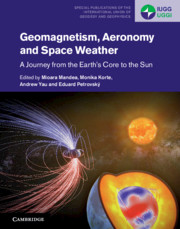Book contents
- Geomagnetism, Aeronomy and Space Weather
- Special Publications of the International Union of Geodesy and Geophysics Series
- Geomagnetism, Aeronomy and Space Weather
- Copyright page
- Contents
- Contributors
- Preface
- Part I Introduction
- Part II Geomagnetic Field
- Part III Spatial and Temporal Variations of the Geomagnetic Field
- 9 Spatial and Temporal Changes of the Geomagnetic Field
- 10 The Global Lithospheric Magnetic Field
- 11 The Ionospheric Field
- 12 The Magnetosphere
- 13 Temporal Field Variations
- Part IV Space Weather
- Part V Magnetic Fields beyond the Earth and beyond Today
- Index
- References
9 - Spatial and Temporal Changes of the Geomagnetic Field
Insights from Forward and Inverse Core Field Models
from Part III - Spatial and Temporal Variations of the Geomagnetic Field
Published online by Cambridge University Press: 25 October 2019
- Geomagnetism, Aeronomy and Space Weather
- Special Publications of the International Union of Geodesy and Geophysics Series
- Geomagnetism, Aeronomy and Space Weather
- Copyright page
- Contents
- Contributors
- Preface
- Part I Introduction
- Part II Geomagnetic Field
- Part III Spatial and Temporal Variations of the Geomagnetic Field
- 9 Spatial and Temporal Changes of the Geomagnetic Field
- 10 The Global Lithospheric Magnetic Field
- 11 The Ionospheric Field
- 12 The Magnetosphere
- 13 Temporal Field Variations
- Part IV Space Weather
- Part V Magnetic Fields beyond the Earth and beyond Today
- Index
- References
Summary
Observational constraints on geomagnetic field changes from interannual to millenial periods are reviewed, and the current resolution of field models (covering archeological to satellite eras) is discussed. With the perspective of data assimilation, emphasis is put on uncertainties entaching Gauss coefficients, and on the statistical properties of ground-based records. These latter potentially call for leaving behind the notion of geomagnetic jerks. The accuracy at which we recover interannual changes also requires considering with caution the apparent periodiObservational constraints on geomagnetic field changes from interannual to millenial periods are reviewed, and the current resolution of field models (covering archeological to satellite eras) is discussed. With the perspective of data assimilation, emphasis is put on uncertainties entaching Gauss coefficients, and on the statistical properties of ground-based records. These latter potentially call for leaving behind the notion of geomagnetic jerks. The accuracy at which we recover interannual changes also requires considering with caution the apparent periodicity seen in the secular acceleration from satellite data. I then address the interpretation of recorded magnetic fluctuations in terms of core dynamics, highlighting the need for models that allow (or pre-suppose) a magnetic energy orders of magnitudes larger than the kinetic energy at large length-scales, a target for future numerical simulations of the geodynamo. I finally recall the first attempts at implementing geomagnetic data assimilation algorithms.city seen in the secular acceleration from satellite data. I then address the interpretation of recorded magnetic fluctuations in terms of core dynamics, highlighting the need for models that allow (or pre-suppose) a magnetic energy orders of magnitudes larger than the kinetic energy at large length-scales, a target for future numerical simulations of the geodynamo. I finally recall the first attempts at implementing geomagnetic data assimilation algorithms.
Keywords
- Type
- Chapter
- Information
- Geomagnetism, Aeronomy and Space WeatherA Journey from the Earth's Core to the Sun, pp. 115 - 132Publisher: Cambridge University PressPrint publication year: 2019
References
- 15
- Cited by



